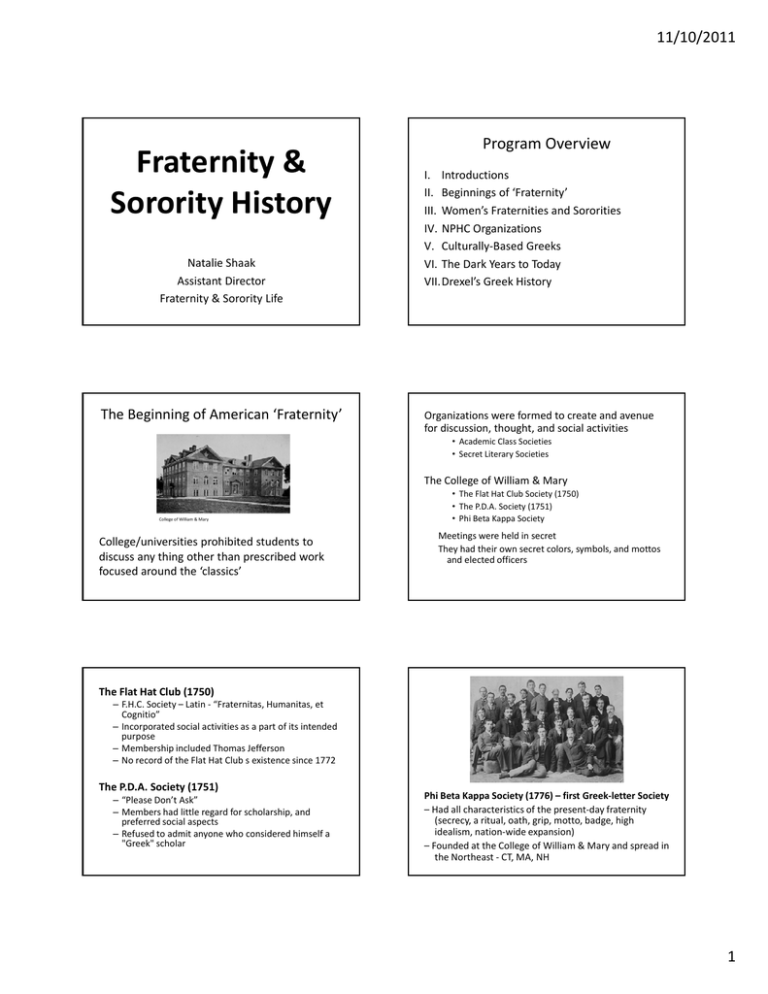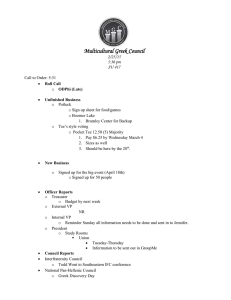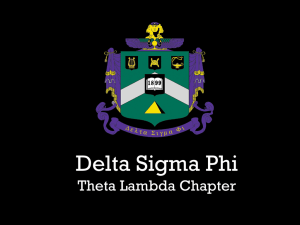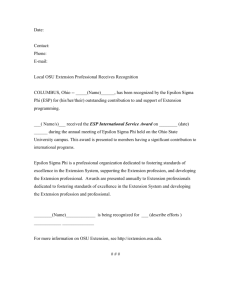Fraternity & Sorority History Program Overview 11/10/2011
advertisement

11/10/2011 Fraternity & Sorority History Natalie Shaak Assistant Director Fraternity & Sorority Life The Beginning of American ‘Fraternity’ Program Overview I. Introductions II. Beginnings of ‘Fraternity’ III. Women’s Fraternities and Sororities IV. NPHC Organizations V. Culturally‐Based Greeks VI. The Dark Years to Today VII.Drexel’s Greek History Organizations were formed to create and avenue for discussion, thought, and social activities • Academic Class Societies • Secret Literary Societies The College of William & Mary College of William & Mary College/universities prohibited students to discuss any thing other than prescribed work focused around the ‘classics’ • The Flat Hat Club Society (1750) The Flat Hat Club Society (1750) • The P.D.A. Society (1751) • Phi Beta Kappa Society Meetings were held in secret They had their own secret colors, symbols, and mottos and elected officers The Flat Hat Club (1750) – F.H.C. Society – Latin ‐ “Fraternitas, Humanitas, et Cognitio” – Incorporated social activities as a part of its intended purpose – Membership included Thomas Jefferson – No record of the Flat Hat Club s existence since 1772 The P.D.A. Society (1751) – “Please Don’t Ask” – Members had little regard for scholarship, and preferred social aspects – Refused to admit anyone who considered himself a "Greek" scholar Phi Beta Kappa Society (1776) – first Greek‐letter Society – Had all characteristics of the present‐day fraternity (secrecy, a ritual, oath, grip, motto, badge, high idealism, nation‐wide expansion) – Founded at the College of William & Mary and spread in the Northeast ‐ CT, MA, NH 1 11/10/2011 Era I of Modern American Fraternities (1825‐1859) • Groups developed because students wanted some control over their lives and wanted to create an organization that would complement and enhance what they learned in the classroom, often allowing free discussion of "controversial material . • Highly secretive. Faculty were threatened by these groups and would enforce retribution, including expulsion. • All of these groups were sectarian – narrowly focused/selective /elite– not inclusive The Union Triad – Union College, NY ‘Mother of Fraternities’ The College Environment • Almost exclusively for white Anglo‐Saxon wealthy protestant upper‐class males studying for the ministry, medicine, and the legal professions • Beginning fraternities were founded by • Beginning fraternities were founded by undergraduates without any assistance from adults • Most of these fraternities were founded as a protest against domination of student activities. As one group formed, others sprang up to compete College life included highly structured days, meager physical environments, and inflexible social rules and regulations. Curriculum was prescribed and focused largely around the “Classics” and Egyptian Classics history Consider what is on your own fraternity/sorority items ‐ crests, shields, badges, etc. The Miami Triad – Miami University, OH ‘Mother of Fraternities’ Kappa Alpha Society (1825) Beta Theta Pi (1839) Sigma Phi Society (1827) Phi Delta Theta (1848) – First of the social college fraternities to establish a branch chapter at Hamilton College (NY) chapter at Hamilton College (NY) – Oldest social fraternity in continued existence Delta Phi Fraternity (1827) – First secret organization to use the name of fraternity instead of society. Three more organizations founded here 1833‐1847: Psi Upsilon, Chi Psi, and Theta Delta Chi Fraternities Sigma Chi (1855) Other Greek organizations founded at Miami: Delta Zeta Sorority (1902) Phi Kappa Tau Fraternity (1906) Delta Sigma Epsilon Sorority (1914) – merged with DZ nationally in 1956 2 11/10/2011 Fraternities founded after 1831 Alpha Delta Phi (1832) – Hamilton College, NY – First college social fraternity to establish a chapter outside of New England, at Miami University, Oxford, OH in 1833 The Social Fraternity of William's College (1834) ‐ MA – Formed as an anti‐secret organization – Has no secret grip, ritual or oath. – Now non‐secret (as opposed to anti‐secret) and is known today as Delta Upsilon Phi Kappa Psi (1852) – Jefferson College, PA – 2 founders tending to sick of the town (typhoid) came to understand “the great joy of serving others” g – Intention was to found an order that would grow to include men of honor and good will at colleges throughout America The Mystical 7 (1837) – Wesleyan University, CT – First fraternity to admit women (1840s) – Emory University, GA (1841) – 1st chapter in the South Theta Chi (1856) ‐ Norwich University, VT – A Chi Psi helped select the secret motto and the design of the badge – Strong influence of a religious denomination – the initiation is influenced by the Episcopalian worship service The Changing College Environment Era II of Modern Fraternities (1860‐1899) • Creation of land‐grant colleges by the Morrill Act of 1862 diversified the curriculum, adding agriculture, engineering, and the sciences to the traditional classics theology and liberal arts traditional classics, theology and liberal arts • Faculty began to welcome student self‐ government • Enrollment grew rapidly and institutions could not house and feed everyone 3 11/10/2011 The Lexington Triad – Virginia • The Civil War had closed many southern chapters and organizations were reluctant to return to the south. A few fraternities were formed specifically to expand in the south and capitalize on the absence of chapters that were once powerful. • The population of the US began to diversify even Th l i f h US b di if faster and this eventually was reflected in the college population. • Diversify population = Diverse campus growth = The creation of…Drexel Institute of Technology in 1891 The Reconstruction Period of Southern Fraternity Alpha Tau Omega (1865) – Virginia Military Institute • 1st fraternity founded after the Civil War • First founded as a national organization Kappa Alpha Order (1865) Washington & Lee University Kappa Alpha Order (1865) ‐ Washington & Lee University Sigma Nu (1869) – Virginia Military Institute Also part of the ‘Virginia Circle’: Kappa Sigma (1919) – University of Virginia Pi Kappa Alpha (1868) – University of Virginia Sigma Phi Epsilon (1901) – Richmond College Fraternities of Era II Pi Kappa Alpha (1868) – University of Virginia, VA – For the first 42 years all chapters were established in the south – Wanted to perpetuate friendships after the war Alpha Chi Rho (1895) – Trinity College, CT – 4 students and an Episcopal clergyman who was a member of Psi Upsilon founded this group Tau Kappa Epsilon (1899) – Illinois Wesleyan, IL – Founded as the Knights of Classic Lore – an organization which should ‘aid development of character and ability of its members’ – At one point had over 300 chapters – the most in fraternity & sorority history Delta Sigma Phi (1899) – City College of New York, NY – Were founded because they as a group of Jewish and Christian men could not join the same fraternity – First chapter was referred to as Insula First chapter was referred to as Insula because of its location because of its location in Manhattan –In 1909, 8 Jewish men tried to join the fraternity at Columbia but were denied and founded national group Phi Sigma Delta; in 1914 amended constitution to only allow Christians (amended again in 1949 to allow all religions and races) Era III of Modern Fraternities (1900‐Present) 4 11/10/2011 The New College Environment Fraternities of Era III Sigma Phi Epsilon (1901) – Richmond College, VA – 12 founders were studying for the ministry – After an unsuccessful attempt to get a Chi Phi charter the group decided to form a new national charter, the group decided to form a new national • Population of campuses was becoming more racially, culturally, and religiously diverse • Many campuses began allowing women to attend in the first years of the century (Note: Drexel was founded in 1891 as co‐ed!) Religiously‐focused Fraternities • Sigma Alpha Mu (1909) ‐ College of the City of New York, NY – Founded by 8 sophomores – First wanted to call them Kappa Phi Omega • Alpha Epsilon Pi (1913) ‐ New York University, NY • Alpha Epsilon Pi (1913) New York University NY – 11 founders were all Jewish and attended night classes • Others: Zeta Beta Tau, Tau Epsilon Phi • Sororities: Alpha Epsilon Phi, Delta Pi, Sigma Delta Tau, Sigma Alpha Epsilon Pi Women’s Fraternities Pi Kappa Phi (1904) – College of Charleston, SC – Founded by 3 friends at the College of Charleston North‐American Interfraternity Conference (NIC) • Founded in 1909 • R Represents 74 inter/national t 74 i t / ti l fraternities (including some NPHC and multicultural fraternities) as of January 2011 “Sorority” • From the Latin word soror, meaning sister • Coined by a Latin professor, who believed using the term “Fraternity” was not wise i h “ i ” i • Many women’s groups still go by the title of ‘women’s fraternity’ because that is how they were incorporated Drexel (approx. 1925) 5 11/10/2011 The 3 Firsts Alpha Delta Pi (1851) – Wesleyan Female College, GA – First female secret society, a book club – Founded as the Adelphean Society – adopted Greek letters in 1905 Pi Beta Phi (1867) – Monmouth College, IL – Founded as I.C. Sororsis, adopted Greek letters ΠΒΦin 1888 Kappa Alpha Theta (1870) – Indiana Asbury/DePauw, IN Sorority Growth Phi Mu (1852) ‐ Wesleyan Female College, GA – Nationally founded as the Philomathean Society – 2nd oldest to ADP (1851) at Wesleyan College Delta Zeta (1902) ‐ Miami University, OH – Assisted by Dr. Guy Potter Benton, ΦΔΘ – Merged with a number of national sororities over the years – First Greek letter women’s organization The Syracuse Triad – New York Farmville Four – State Female Normal School (now Longwood University), VA Sigma Sigma Sigma (1898) – Began as secret society, S.S.S. Club; in 1915 absorbed regional organization Sigma Delta Chi Kappa Delta (1898) – Founded by roommate of Tri‐Sigma founder Founded by roommate of Tri Sigma founder Zeta Tau Alpha (1898) • Alpha Phi (1872) • Gamma Phi Beta (1874) • Alpha Gamma Delta (1904) – Third largest NPC organization Alpha Sigma Alpha (1901) – Had only 1 chapter left by 1913; turned to founder Ida Shaw Martin who suggested they install chapter at Miami OH; she served as national pres. of until 1930 *At Longwood there is a 4‐faced clock on campus dedicated to these groups National Panhellenic Conference Phi Sigma Sigma (1913) ‐ Hunter College, NY – First non‐sectarian sorority (open to all religions) • Founded in 1902 • Oversees 26 National S Sororities iti • No new groups added since 1951 Delta Phi Epsilon – (1917) – New York University, NY – Law School – Non‐sectarian ritual as well 6 11/10/2011 National Pan‐Hellenic Council (NPHC) Organizations NPHC Fraternities Alpha Phi Alpha (1906) – Founded for black men not being admitted to existing college fraternities because of their race – Founded at Cornell University, NY Kappa Alpha Psi (1911) – Founded at Indiana University as Kappa Alpha Nu; HQ located in Philadelphia Omega Psi Phi (1911) – Howard University, Washington D.C. – First fraternity founded at an HBCU NPHC Sororities Phi Beta Sigma (1914) – A predominantly African‐American fraternity founded by 3 black undergraduates at Howard University – Now, nationally the most diverse of the NPHC groups N ti ll th t di f th NPHC Iota Phi Theta (1963) – Founded at Morgan State University, Baltimore, in the midst of the Civil Rights Movement – More radical than other NPHC groups – inspired by Malcolm X and Black Panthers Alpha Kappa Alpha (1908) ‐Howard University, DC – First African‐American sorority Delta Sigma Theta (1913) ‐ Howard University, DC – Founded by 22 former members of AKA Governing Council (NPHC) Zeta Phi Beta (1920) ‐ Howard University, DC – Sister organization to Phi Beta Sigma Fraternity – 1923 – first black sorority in Texas Sigma Gamma Rho (1922) ‐ Butler University, IN – Only NPHC sorority founded at predominantly white campus • Founded in 1930 • Known as the ‘Divine Nine’ • Originally just 8 groups, Iota O i i ll j 8 I Phi Theta was not admitted until 1997 • Graduate initiation/graduate chapters 7 11/10/2011 Culturally‐based Greeks Early Cultural Greeks • Founded in 1900s to 1970s • Created to support small minority population on campuses on campuses • Cultural minorities were unable to join ‘traditional groups’ Early Cultural Greeks Examples: – Rho Psi (1916, Cornell)– 1st Asian fraternity – said to be inspired by founding of Alpha Phi Alpha – now a professional society – Chi Alpha Delta Sorority (1929, UCLA) – Asian‐ American – Phi Iota Alpha Fraternity (1931, RPI) – oldest active Latino fraternity – Lambda Theta Alpha Sorority (1975, Kean, NJ) ‐ Latina Later Cultural Greeks Examples: – Chi Upsilon Sigma (1980, Rutgers) – Lambda Upsilon Lambda (1982, Cornell) – Iota Nu Delta Fraternity (1994, Binghamton U) – 1st South‐ Asian fraternityy – Sigma Psi Zeta Sorority (1994, U of Albany) – 1st Asian interest sorority founded on the East coast – Sigma Beta Rho Fraternity (1996, Penn) – multicultural – Delta Phi Omega Sorority(1998, U of Houston) – South‐Asian – Delta Epsilon Psi Fraternity (1998, UT Austin) – South‐Asian – Kappa Phi Gamma Sorority (1998, UT Austin) – South‐Asian Later Cultural Greeks • Founded in late 1970s to present • Created to celebrate various cultures • Cultural minorities were becoming larger in Cultural minorities were becoming larger in numbers at universities across the country • Asian F/S founded mostly in New York and Texas Later Cultural Greeks Now national groups to celebrate all cultures: • Latino/Hispanic (Lambda Theta Phi) • Native American (Alpha Pi Omega) Native American (Alpha Pi Omega) • Christian (Alpha Delta Chi) • Muslim (Gamma Gamma Chi) • Multicultural (Mu Sigma Upsilon) • LGBT (Delta Lambda Phi) 8 11/10/2011 Later Cultural Greeks The Dark Years (1970/80’s to mid 1990’s) Umbrella Organizations *NAPA – 2004 – 9 organizations *NALFO – 1998 – 20 organizations *NMGC – 1998 – 10 organizations Characterized by… Kegs Hazing Chapter Closing Little Support Policy creation & implementation • Few values‐based discussions • • • • • The Call for Values Congruence 1. Reaffirm focus on academics as first priority • Five‐day academic week • Campus‐based advisors • Academic Requirements • Recognize contributions of groups to the campus The Call for Values Congruence In 2001, university presidents, leaders of higher education organizations and inter/national Greek organizations joined to develop a presidential initiative to transform the collegiate Greek environment It outlines a specific set of strategies that campuses with negative Greek behavioral issues should use to close the gap between what fraternities/sororities espouse and what their chapters do and hold them accountable and includes specific standards for Greek communities Drexel Greek History (1900‐present) 2. Communicate expectations of groups clearly • Improve communication • Enforce alcohol policies • Chapter and university engage in conversations 3. Encourage and develop alcohol policies and education 4. Utilize ‘certification’ process to hold chapters accountable to set community‐wide standards 5. Promote healthy lifestyles 6. Adopt clear recognition policy including expectations & policies Panhellenic Council (1929) 9 11/10/2011 Drexel Fraternities (IFC) 1900 – Lambda Upsilon Delta (C‐1908) – First Fraternity 1905 – Tau Rho Delta (C‐1915) 1909 – Alpha Phi (C‐1911) 1919 – Kappa Sigma Delta >1933> Pi Kappa Phi (rc 2008) 1919 – Phi Kappa Beta >1939> Tau Kappa Epsilon 1921 – Kappa Phi Delta >1947> Sigma Alpha Mu (rc 2009) 1924 – Alpha Upsilon Mu >1941> Lambda Chi Alpha (rc 2009) 1927 – Delta Sigma Alpha >1940> Theta Chi 1935 – Alpha Pi Lambda (rc 2006) 1948 – Phi Tau Delta >1950> Sigma Pi (C) 1949 – Delta Kappa Rho >1965> Phi Sigma Kappa (C) 1953 – Phi Omega >1956> Delta Sigma Phi (C‐2008; rc 2011) 1954 – Alpha Beta Delta >1955> Tau Epsilon Phi (C) 1962 – Delta Iota >1965> Pi Lambda Phi (C) 1963 – Beta Nu (C‐1968) 1966 – Sigma Alpha Theta >1971> Sigma Alpha Epsilon (rc 2007; C‐2010) 1983 – Phi Kappa Sigma (C) 1992 – Alpha Chi Rho 1992 Alpha Chi Rho (rc 1997) 1995 – Alpha Epsilon Pi 1999 – Sigma Phi Epsilon 2001 – Phi Kappa Psi 2001 – Pi Kappa Alpha (1974) Drexel Sororities (PHC) 1921 ‐ Phi Delta Mu >> Sigma Sigma Sigma (C ‐ 1974; rc 2011) 1922 – Omega Delta Epsilon >> Alpha Sigma Alpha 1924 – Kappa Delta Gamma >> D l Si Delta Sigma Epsilon >>Delta Zeta E il D l Z 1934 – Pi Sigma Gamma (C) 1941 – Sigma Omicron Pi (C) 1947 – Delta Phi Epsilon (rc 2003) 1954 – Phi Mu 1959 – Omega Phi >> Phi Sigma Sigma (1960’s) (1960’s) Drexel Multicultural Greeks (MGC) 1920 – Alpha Phi Alpha Fraternity (C‐2007; rc fall 2011)* 1945 ‐ Alpha Kappa Alpha Sorority (rc 2008)* 1952 – Kappa Alpha Psi Fraternity* 1966 – Delta Sigma Theta Sorority (rc 2008)* 1988 – Lambda Upsilon Lambda Fraternity(C)* 1996 – Iota Phi Theta Fraternity (C) p g y 1997 – Chi Upsilon Sigma Sorority 1997 – Iota Nu Delta Fraternity (rc 2008) 1998 – Phi Beta Sigma Fraternity (C) 2000 – Delta Phi Omega Sorority* 2002 – Sigma Psi Zeta Sorority 2002 – Sigma Beta Rho Fraternity (rc 2008) 2004 – Sigma Lambda Upsilon Sorority (C) 2005 – Zeta Phi Beta Sorority (C‐2008) 2010 – Delta Epsilon Psi Fraternity 2011 – Kappa Phi Gamma Sorority 10




